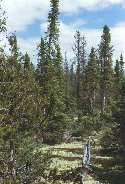









|
|
The Lower Foothills Vegetation
 The forests reflect the transitional nature of this subregion in which mixed forests of
White Spruce, Black Spruce, Lodgepole Pine, Balsam Fir, Aspen, Paper
Birch, and Balsam Poplar occur. Lodgepole pine communities are perhaps the best indication of the lower boundary of this subregion with the adjacent
Boreal Forest mixedwood forests. The upper boundary to the Upper Foothills Subregion is marked by the absence of mixed
deciduous-coniferous forests (absence of Aspen, Balsam Poplar and birch) and the occurrence of a nearly pure
coniferous forest cover. The forests reflect the transitional nature of this subregion in which mixed forests of
White Spruce, Black Spruce, Lodgepole Pine, Balsam Fir, Aspen, Paper
Birch, and Balsam Poplar occur. Lodgepole pine communities are perhaps the best indication of the lower boundary of this subregion with the adjacent
Boreal Forest mixedwood forests. The upper boundary to the Upper Foothills Subregion is marked by the absence of mixed
deciduous-coniferous forests (absence of Aspen, Balsam Poplar and birch) and the occurrence of a nearly pure
coniferous forest cover.
At lower elevations and along the eastern edge of the subregion, introgressive hybridization between lodgepole pine, a cordilleran species, and
Jack Pine, a boreal species, occurs.
Lodgepole Pine forests occupy extensive portions of the upland in this subregion, especially following fire. Understory species on drier sites include buffaloberry, white meadowsweet, junipers, bearberry, and low bilberry. On more mesic sites,
White Spruce and Aspen are more frequent in the tree layer and the understory contains a large number of species including
Prickly Rose, Labrador Tea, Bunchberry, Twinflower,
 Fireweed, Bog Cranberry, and the feathermosses. As a result of
succession, White Spruce and, in the north,
Black Spruce, likely will eventually replace Lodgepole Pine and Aspen in these communities in the absence of fire.
Fireweed, Bog Cranberry, and the feathermosses. As a result of
succession, White Spruce and, in the north,
Black Spruce, likely will eventually replace Lodgepole Pine and Aspen in these communities in the absence of fire.
Black Spruce forests occur on moist upland sites in the north but the species
generally does not occur south of the Red Deer River, although one small, disjunct stand is known near Bragg Creek. Black
Spruce also occurs on wet Organic soils (muskegs). Typical understory species include Labrador
Tea, Dwarf Birch, Bracted Honeysuckle, horsetails, Bishop's Cap,
Twinflower, peat mosses, and the
 brown mosses. brown mosses.
Fens, both patterned and unpatterned, are common in much of this subregion. These communities typically contain scattered trees of
Black Spruce and Tamarack with an understory of Dwarf Birch, Labrador
Tea, willow, sedges, bog bean, Tufted Hairgrass, and both peat and brown mosses.
[Geology
and Landforms][Climate][Soils]
[Vegetation][Wildlife]
|
 Heritage Community Foundation Presents
Heritage Community Foundation Presents













